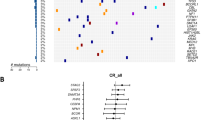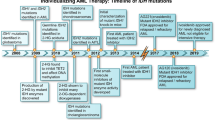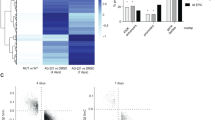Abstract
Although targeted therapies have proven effective and even curative in human leukaemia, resistance often ensues. IDH enzymes are mutated in ~20% of human AML, with targeted therapies under clinical evaluation. We here characterize leukaemia evolution from mutant IDH2 (mIDH2)-dependence to independence identifying key targetable vulnerabilities of mIDH2 leukaemia that are retained during evolution and progression from early to late stages. Mechanistically, we find that mIDH2 leukaemia are metastable and vulnerable at two distinct levels. On the one hand, they are characterized by oxidative and genotoxic stress, in spite of increased 1-carbon metabolism and glutathione levels. On the other hand, mIDH2 leukaemia display inhibition of LSD1 and a resulting transcriptional signature of all-trans retinoic acid (ATRA) sensitization, in spite of a state of suppressed ATRA signalling due to increased levels of PIN1. We further identify GSH/ROS and PIN1/LSD1 as critical nodes for leukaemia maintenance and the combination of ATRA and arsenic trioxide (ATO) as a key therapeutic modality to target these vulnerabilities. Strikingly, we demonstrate that the combination of ATRA and ATO proves to be a powerfully synergistic and effective therapy in a number of mouse and human mIDH1/2 leukemic models. Thus, our findings pave the way towards the treatment of a sizable fraction of human AMLs through targeted APL-like combinatorial therapies.
Similar content being viewed by others
Log in or create a free account to read this content
Gain free access to this article, as well as selected content from this journal and more on nature.com
or
References
Chen, C. et al. Cancer-associated IDH2 mutants drive an acute myeloid leukemia that is susceptible to Brd4 inhibition. Genes Dev. 27, 1974–1985 (2013).
Fujii, T., Khawaja, M. R., DiNardo, C. D., Atkins, J. T. & Janku, F. Targeting isocitrate dehydrogenase (IDH) in cancer. Discov. Med. 21, 373–380 (2016).
Losman, J. A. & Kaelin, W. G. Jr. What a difference a hydroxyl makes: mutant IDH, (R)-2-hydroxyglutarate, and cancer. Genes Dev. 27, 836–852 (2013).
Garraway, L. A. & Lander, E. S. Lessons from the cancer genome. Cell 153, 17–37 (2013).
Chan, S. M. et al. Isocitrate dehydrogenase 1 and 2 mutations induce BCL-2 dependence in acute myeloid leukemia. Nat. Med. 21, 178–184 (2015).
Clark, O., Yen, K. & Mellinghoff, I. K. Molecular pathways: isocitrate dehydrogenase mutations in cancer. Clin. Cancer Res. 22, 1837–1842 (2016).
Dang, L., Yen, K. & Attar, E. C. IDH mutations in cancer and progress toward development of targeted therapeutics. Ann. Oncol. 27, 599–608 (2016).
Amatangelo, M. D. et al. Enasidenib induces acute myeloid leukemia cell differentiation to promote clinical response. Blood 130, 732–741 (2017).
Holohan, C., Van Schaeybroeck, S., Longley, D. B. & Johnston, P. G. Cancer drug resistance: an evolving paradigm. Nat. Rev. Cancer 13, 714–726 (2013).
Stein, E. M. et al. Enasidenib in mutant IDH2 relapsed or refractory acute myeloid leukemia. Blood 130, 722–731 (2017).
Intlekofer, A. M. et al. Acquired resistance to IDH inhibition through trans or cis dimer-interface mutations. Nature 559, 125–129 (2018).
Quek, L. et al. Clonal heterogeneity of acute myeloid leukemia treated with the IDH2 inhibitor enasidenib. Nat. Med. 24, 1167–1177 (2018).
Kats, L. M. et al. Proto-oncogenic role of mutant IDH2 in leukemia initiation and maintenance. Cell Stem Cell 14, 329–341 (2014).
Mentch, S. J. & Locasale, J. W. One-carbon metabolism and epigenetics: understanding the specificity. Ann. N. Y. Acad. Sci. 1363, 91–98 (2016).
Sykes, D. B. et al. Inhibition of dihydroorotate dehydrogenase overcomes differentiation blockade in acute myeloid leukemia. Cell 167, 171–186 e115 (2016).
Couto, N., Wood, J. & Barber, J. The role of glutathione reductase and related enzymes on cellular redox homoeostasis network. Free Radic. Biol. Med. 95, 27–42 (2016).
Noguera, N. I. et al. High-dose ascorbate and arsenic trioxide selectively kill acute myeloid leukemia and acute promyelocytic leukemia blasts in vitro. Oncotarget 8, 32550–32565 (2017).
Granito, A. et al. PML nuclear body component Sp140 is a novel autoantigen in primary biliary cirrhosis. Am. J. Gastroenterol. 105, 125–131 (2010).
Zucchelli, C. et al. Structure of human Sp140 PHD finger: an atypical fold interacting with Pin1. Febs. J. 281, 216–231 (2014).
Gombart, A. F. & Koeffler, H. P. Neutrophil specific granule deficiency and mutations in the gene encoding transcription factor C/EBP(epsilon). Curr. Opin. Hematol. 9, 36–42 (2002).
Friedman, A. D. C/EBPalpha in normal and malignant myelopoiesis. Int. J. Hematol. 101, 330–341 (2015).
Patial, S. et al. Enhanced stability of tristetraprolin mRNA protects mice against immune-mediated inflammatory pathologies. Proc. Natl Acad. Sci. USA 113, 1865–1870 (2016).
Cauchy, P. et al. Chronic FLT3-ITD signaling in acute myeloid leukemia is connected to a specific chromatin signature. Cell Rep. 12, 821–836 (2015).
Schenk, T. et al. Inhibition of the LSD1 (KDM1A) demethylase reactivates the all-trans-retinoic acid differentiation pathway in acute myeloid leukemia. Nat. Med 18, 605–611 (2012).
Martens, J. H. et al. PML-RARalpha/RXR alters the epigenetic landscape in acute promyelocytic leukemia. Cancer Cell 17, 173–185 (2010).
Boutzen, H. et al. Isocitrate dehydrogenase 1 mutations prime the all-trans retinoic acid myeloid differentiation pathway in acute myeloid leukemia. J. Exp. Med. 213, 483–497 (2016).
Wang, F. et al. Targeted inhibition of mutant IDH2 in leukemia cells induces cellular differentiation. Science 340, 622–626 (2013).
Gianni, M. et al. Inhibition of the peptidyl-prolyl-isomerase Pin1 enhances the responses of acute myeloid leukemia cells to retinoic acid via stabilization of RARalpha and PML-RARalpha. Cancer Res. 69, 1016–1026 (2009).
Wei, S. et al. Active Pin1 is a key target of all-trans retinoic acid in acute promyelocytic leukemia and breast cancer. Nat. Med. 21, 457–466 (2015).
Brondani, V., Schefer, Q., Hamy, F. & Klimkait, T. The peptidyl-prolyl isomerase Pin1 regulates phospho-Ser77 retinoic acid receptor alpha stability. Biochem. Biophys. Res. Commun. 328, 6–13 (2005).
Marchwicka A., Marcinkowska E. Regulation of expression of CEBP genes by variably expressed vitamin D receptor and retinoic acid receptor alpha in human acute myeloid leukemia cell lines. Int. J. Mol. Sci. 19, 50–63 (2018).
Grignani, F. et al. The acute promyelocytic leukemia-specific PML-RAR alpha fusion protein inhibits differentiation and promotes survival of myeloid precursor cells. Cell 74, 423–431 (1993).
Testa, U. et al. PML/RAR alpha + U937 mutant and NB4 cell lines: retinoic acid restores the monocytic differentiation response to vitamin D3. Cancer Res. 54, 4508–4515 (1994).
Ghaffari, S. H. et al. Cytotoxic effect of arsenic trioxide on acute promyelocytic leukemia cells through suppression of NFkbeta-dependent induction of hTERT due to down-regulation of Pin1 transcription. Hematology 17, 198–206 (2012).
Kozono, S. et al. Arsenic targets Pin1 and cooperates with retinoic acid to inhibit cancer-driving pathways and tumor-initiating cells. Nat. Commun. 9, 3069 (2018).
Reineke, E. L. et al. Degradation of the tumor suppressor PML by Pin1 contributes to the cancer phenotype of breast cancer MDA-MB-231 cells. Mol. Cell. Biol. 28, 997–1006 (2008).
Yang D. et al. A novel controlled release formulation of the Pin1 inhibitor ATRA to improve liver cancer therapy by simultaneously blocking multiple cancer pathways. J. Control Release 2018;269:405–422.
Forghieri, F. et al. All-trans retinoic acid (ATRA) in non-promyelocytic acute myeloid leukemia (AML): results of combination of ATRA with low-dose Ara-C in three elderly patients with NPM1-mutated AML unfit for intensive chemotherapy and review of the literature. Clin. Case Rep. 4, 1138–1146 (2016).
Costantino, S., Paneni, F., Luscher, T. F. & Cosentino, F. Pin1 inhibitor Juglone prevents diabetic vascular dysfunction. Int. J. Cardiol. 203, 702–707 (2016).
Boussetta, T. et al. The prolyl isomerase Pin1 acts as a novel molecular switch for TNF-alpha-induced priming of the NADPH oxidase in human neutrophils. Blood 116, 5795–5802 (2010).
Pinton, P. et al. Protein kinase C beta and prolyl isomerase 1 regulate mitochondrial effects of the life-span determinant p66Shc. Science 315, 659–663 (2007).
Carracedo, A., Cantley, L. C. & Pandolfi, P. P. Cancer metabolism: fatty acid oxidation in the limelight. Nat. Rev. Cancer 13, 227–232 (2013).
de The, H., Pandolfi, P. P. & Chen, Z. Acute promyelocytic leukemia: a paradigm for oncoprotein-targeted cure. Cancer Cell 32, 552–560 (2017).
Mason, E. F., Kuo, F. C., Hasserjian, R. P., Seegmiller, A. C. & Pozdnyakova, O. A distinct immunophenotype identifies a subset of NPM1-mutated AML with TET2 or IDH1/2 mutations and improved outcome. Am. J. Hematol. 93, 504–510 (2018).
Chevillard, S. A method for sequential extraction of RNA and DNA from the same sample, specially designed for a limited supply of biological material. Biotechniques 15, 22–24 (1993).
Mugoni, V. et al. Ubiad1 is an antioxidant enzyme that regulates eNOS activity by CoQ10 synthesis. Cell 152, 504–518 (2013).
Reschke, M. et al. Characterization and analysis of the composition and dynamics of the mammalian riboproteome. Cell Rep. 4, 1276–1287 (2013).
Acknowledgements
We thank all members of the Pandolfi laboratory for critical comments. Lauren Southwood and Elizabeth Stack for editing the manuscript. We are grateful to Markus Reschke, Akinobu Matsumoto, Nicole Pandell, Valerie Maymi, John Asara, John F. Daley and Zach Herbert for technical support with experiments. We are also thankful to Jacqueline Fung and Jesse M. Katon for their technical help and to Kun Ping Lu for support and reagents. V.M. was supported by EMBO Long Term post-doctoral fellowship (ALTF 1011–2014), European Commission (LTFCOFUND2013, GA-2013–609409) and by the Leukaemia and Lymphoma Society (Career Development Program, Grant number: 5437–16). R.P. was partially supported by Marie Curie Action Fellowship “Mobility Program for post graduated scientists in Life Sciences” (C.I.13001124001202512454). E.M. is supported by the Società Italiana di Biofisica e Biologia Molecolare (SIBBM). This work was supported in part by the Ludwig Center at Harvard and NIH/NCI grants R35CA197529. and R01CA142874 to P.P.P.
Author information
Authors and Affiliations
Contributions
P.P.P., V.M. and J.G.C. conceived the hypothesis, planned and designed the experiments and wrote the paper. L.L. managed the study. V.M. performed in vivo and in vitro experiments regarding mouse, human leukaemia primary cells and cell lines. V.M. engineered TF1 cell line for Pin1 overexpression or silencing. V.M and R.P. engineered the U937 and TF1 cell lines for the stable expression of the mutant variants R140Q of IDH2 and R132C of IDH1 and performed in vivo and in vitro experiments, real-time qRT-PCR and FACS analysis. M.C. performed western blot analyses on mouse and human leukaemia cells. G.C. performed colony assays on human mIDH AML. V.M and J.G.C. performed the pre-clinical trials, O.P. performed histopathological analyses, A.V.M., J.G.C., L.M., D.S., J.G., D.A., J.C.Z. and F.L. contributed to in vitro and in vivo experiments. J.C.A., A.L., R.M.S., I.G., D.S., D.A. and J.C.Z. provided human primary patient AML samples. E.M., J.D.L. and M.K.B. performed the bioinformatics analysis of the data.
Corresponding author
Ethics declarations
Competing interests
P.P.P. is a member of the Scientific Advisory Board of Agios Pharmaceuticals, Cambridge, MA. P.P.P., V.M., J.G.C. and M.C. have filed a U.S. Patent Application No. 62/593,761, entitled “ARSENIC TRIOXIDE AND RETINOIC ACID COMPOUNDS FOR TREATMENT OF IDH2-ASSOCIATED DISORDERS”, filed December 1, 2017. This application is still pending. The remaining authors declare no competing interests.
Supplementary information
Rights and permissions
About this article
Cite this article
Mugoni, V., Panella, R., Cheloni, G. et al. Vulnerabilities in mIDH2 AML confer sensitivity to APL-like targeted combination therapy. Cell Res 29, 446–459 (2019). https://doi.org/10.1038/s41422-019-0162-7
Received:
Accepted:
Published:
Issue date:
DOI: https://doi.org/10.1038/s41422-019-0162-7
This article is cited by
-
Reciprocal antagonism of PIN1-APC/CCDH1 governs mitotic protein stability and cell cycle entry
Nature Communications (2024)
-
Pediatric glioma histone H3.3 K27M/G34R mutations drive abnormalities in PML nuclear bodies
Genome Biology (2023)
-
Update on Small Molecule Targeted Therapies for Acute Myeloid Leukemia
Current Treatment Options in Oncology (2023)
-
Treating leukemia: differentiation therapy for mIDH2 AML
Cell Research (2019)



